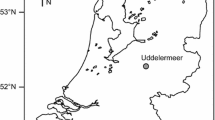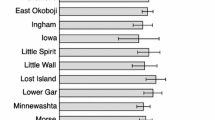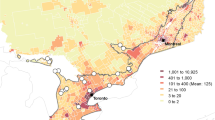Abstract
Diatom and geochemical data from Crawford Lake, Ontario, have been used to document limnological responses to periods of cultural disturbance resulting from native Iroquoian occupation of the watershed (1268–1486 AD) and Euro-Canadian agriculture and deforestation (1867 AD–present). Here, we further develop the high-resolution nature of the Crawford Lake sediment record to examine the physical, chemical and biological aspects of limnological response to human disturbances in the lake catchment area with exceptional detail. We report detailed diatom abundance and flux data for individual taxa from Crawford Lake, and further describe the relationship between assemblage composition and environmental conditions using canonical correspondence analysis (CCA). Diatom assemblage data are used to calculate diatom inferred-total phosphorus (DI-TP) concentrations for the past ∼1,000 years. We also examine the diatom community response during and after periods of disturbance by Iroquoian and Euro-Canadian populations, and compare this response to existing geochemical proxies of lake production and new elemental geochemical indicators of catchment area erosion. In particular, we explore the differing limnological response to the two distinct periods of cultural eutrophication and examine the limnological processes that occurred during the period of␣low (or no) human activity (1487–1866 AD), when geochemical indicators of lake production recovered to pre-disturbance conditions, but diatom assemblages notably did not. Our results illustrate the highly susceptible nature of diatom communities to periods of anthropogenic disturbance, and emphasize that ecological indicators (such as diatom assemblages) should be included with other proxies (such as nutrient concentrations and physical characteristics) when assessing disturbance and recovery in lake systems.
Similar content being viewed by others
References
Battarbee RW (1973) A new method for the estimation of absolute microfossil numbers, with reference especially to diatoms. Limnol Oceanogr 18:647–653
Birks HJB, Line JM, Juggins S, Stevenson AC, ter Braak CJF (1990) Diatoms and pH reconstruction. Philos Trans R Soc Lond B Biol Sci 327:263–278
Byrne R, McAndrews JH (1975) Pre-Columbian purslane (Portulaca oleracea L.) in the new world. Nature 253:726–727
Boyko-Diakonow M (1979) The laminated sediments of Crawford Lake, southern Ontario, Canada. In: Schlüchter C (eds) Moraines and varves. A.A. Balkema, Rotterdam, pp 303–307
Campbell ID, Campbell C (1994) The impact of late woodland land use on the forest landscape of Southern Ontario. Great Lake Geog 1:22–29
Campbell ID, McAndrews JH (1993) Forest disequilibrium caused by rapid Little Ice age cooling. Nature 366:336–338
Clark JS, Royall PD (1995) Transformation of a northern hardwood forest by aboriginal (Iroquois) fire: charcoal evidence from Crawford Lake, Ontario, Canada. Holocene 5:1–9
Dokulil MT, Teubner K (2005) Do phytoplankton communities correctly track trophic changes? An assessment using directly measured and paleolimnological data. Fresh Biol 50:1594–1604
Douglas MSV, Smol JP, Savelle JM, Blais JM (2004) Prehistoric Inuit whalers affected Arctic freshwater ecosystems. Proc Natl Acad Sci USA 101:1613–1617
Ekdahl EJ, Teranes JL, Guilderson TP, Wittkop CA, Turton CF, McAndrews JH, Stoermer EF (2004) A prehistorical record of cultural eutrophication from Crawford Lake, Ontario. Geology 32:745–748
Engstrom DR, Swain EB, and Kingston JC (1985) A palaeolimnological record of human disturbance from Harvey’s Lake, Vermont: geochemistry, pigments, and diatoms. Fresh Biol 15:261–288
Finlayson WD (1998) Iroquoian peoples of the land of rocks and water, A.D. 1000–1650: A study in settlement archaeology. London Museum of Archaeology, Ontario, Canada
Garrison PJ, Fitzgerald SA (2005) The role of shoreland development and commercial cranberry farming in a lake in Wisconsin, USA. J Paleolimnol 33:169–188
Hollander DJ, Smith MA (2001) Microbially mediated carbon cycling as a control on the δ13C of sedimentary carbon in eutrophic Lake Mendota (USA): new models for interpreting isotopic excursions in the sedimentary record. Geochim Cosmochim Acta 65:4321–4337
Jeppesen E, Søndergaard M, Jensen JP, Lauridsen TL (2003) Restoration of eutrophic lakes: a global perspective. In: Kumagi M, Vincent WF (eds) Freshwater management: global versus local perspectives. Springer, Tokyo, Japan, pp 135–151
Juggins S (2003) C2 user guide. Software for ecological and palaeoecological data analysis and visualisation. University of Newcastle, Newcastle upon Tyne, Britain
Krammer KH, Lange-Bertalot H (1986–1991) Bacillariophycea, Süßwasserflora von Mitteleuropa, Bd. 2, Teil 1–4: Bacillariophyceae. Gustav Fischer Verlag, Stuttgart, Germany
Laird KR, Fritz SC, Cumming BF, Grimm EC (1998) Early-holocene limnological and climatic variability in the Northern Great Plains. Holocene 8:275–285
Lowe R (1996) Periphyton patterns in lakes. In: Stevenson RJ, Bothwell ML, Lowe RL (eds) Algal ecology: freshwater benthic ecosystems. Academic Press, London, pp 57–76
McAndrews JH, Boyko-Diakonow M (1989) Pollen analysis of varved sediment at Crawford Lake, Ontario: evidence of Indian and European farming. In: Fulton RJ (ed) Quaternary geology of Canada and Greenland. Geol Soc Am, Boulder, Colorado, USA, pp 528–530
Meyers PA, Teranes JL (2001) Sediment organic matter. In: Last WM, Smol JP (eds) Tracking environmental change using lake sediments, Physical and geochemical methods, vol 2. Kluwer, Dordrecht, The Netherlands, pp 239–269
Miettinen JO, Simola H, Grönlund E, Lahtinen J, Niinioja R (2005) Limnological effects of growth and cessation of agricultural land use in Ladoga Karelia: sedimentary pollen and diatom analyses. J Paleolimnol 34:229–243
Ohlendorf C, Sturm M, Hausmann S (2003) Natural environmental changes and human impact reflected in sediments of a high alpine lake in Switzerland. J Paleolimnol 30:297–306
Patrick R, Reimer C (1966) Monograph series of the academy of natural sciences of Philadelphia #13: Diatoms of the United States. Philadelphia Academy of Natural Sciences Press, Philadelphia, USA
Ramstack JH, Fritz SC, Engstrom DR, Heiskary SA (2003) The application of a diatom-based transfer function to evaluate regional water-quality trends in Minnesota since 1970. J Paleolimnol 29:79–94
Reavie ED, Smol JP (2001) Diatom-environmental relationships in 64 alkaline southeastern Ontario (Canada) lakes: a diatom-based model for water quality reconstructions. J Paleolimnol 25:25–42
Renberg I, Korsman T, Birks HJB (1993) Prehistoric increases in the pH of acid-sensitive Swedish lakes caused by land-use changes. Nature 362:824–827
Rybak M, Dickman M (1988) Paleoecological reconstruction of changes in the productivity of a small, meromictic lake in southern Ontario, Canada. Hydrobiologia 169:293–306
Smith VH (2003) Eutrophication of freshwater and coastal marine ecosystems—a global problem. Environ Sci Pollut Res Int 10:126–139
Smol JP, Boucherle MM (1985) Postglacial changes in algal and cladoceran assemblages in Little Round Lake, Ontario. Arch Hydrobiol 103:25–49
Søndergaard, M, Jensen JP, Jeppesen E (2003) Role of sediment and internal loading of phosphorus in shallow lakes. Hydrobiologia 506(509):135–145
Stoermer EF, Edlund MB, Pilskaln CH, Schelske CL (1995) Siliceous microfossil distribution in the surficial sediments of Lake Baikal. J Paleolimnol 14:69–82
Stoermer EF, Emmer G, Julius ML, Schelske CL (1996) Paleolimnologic evidence of rapid recent change in Lake Erie’s trophic status. Can J Fish Aquat Sci 53:1451–1458
Stoermer EF, Ladewski BG, Schelske CL (1978) Population responses of Lake Michigan phytoplankton to nitrogen and phosphorus enrichment. Hydrobiologia 57:249–265
Stoermer EF, Yang JJ (1971) Contributions to the diatom flora of the Laurentian Great Lakes. I. New and little-known species of Amphora (Bacillariophyta Pennatibacillariophyceae). Phycologia 10:397–408
ter Braak CJF (1986) Canonical correspondence analysis: a new eigenvector technique for multivariate direct gradient analysis. Ecology 67:1167–1179
ter Braak CJF, Šmilauer P (1998) CANOCO Reference Manual and User’s Guide to Canoco for Windows: Software for canonical community ordination (version 4). Microcomputer Power, Ithaca New, York, 352 pp
Teranes JL, Bernasconi SM (2005) Factors controlling δ13C of sedimentary carbon in hypertrophic Baldeggersee, Switzerland and implications for interpreting isotope excursions in lake sedimentary records. Limnol Oceanogr 50:914–922
Vadeboncoeur Y, Jeppesen E, Vander Zanden MJ, Christoffersen K, Lodge DM (2003) From Greenland to green lakes: cultural eutrophication and the loss of benthic pathways in lakes. Limnol Oceanogr 48:1408–1418
Warrick G (2000) The precontact Iroquoian occupation of Southern Ontario. J World Prehist 14:415–466
Williams DD, Williams NE, Cao Y (1999) Road salt contamination of groundwater in a major metropolitan area and development of a biological index to monitor its impact. Water Res 34:127–138
Wolin JA, Stoermer EF (2005) Response of a Lake Michigan coastal lake to anthropogenic catchment disturbance. J Paleolimnol 33:73–94
Acknowledgements
Funding was provided by University of Michigan Turner Awards to E.J.E. We gratefully acknowledge Janice Papas for assistance with statistical techniques and manuscript comments, Lynn Walter and Tim Ku for assistance with water chemistry analyses and interpretation, Walt Dean for providing elemental analyses, and Norman Andresen for laboratory assistance. Two anonymous reviewers provided assistance in revising an earlier version of this manuscript.
Author information
Authors and Affiliations
Corresponding author
Rights and permissions
About this article
Cite this article
Ekdahl, E.J., Teranes, J.L., Wittkop, C.A. et al. Diatom assemblage response to Iroquoian and Euro-Canadian eutrophication of Crawford Lake, Ontario, Canada. J Paleolimnol 37, 233–246 (2007). https://doi.org/10.1007/s10933-006-9016-7
Received:
Accepted:
Published:
Issue Date:
DOI: https://doi.org/10.1007/s10933-006-9016-7




